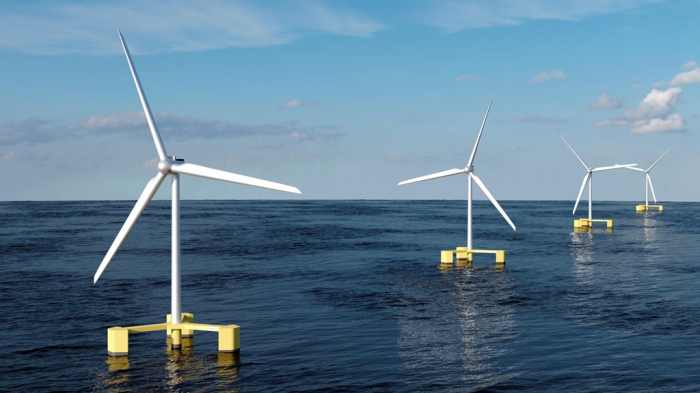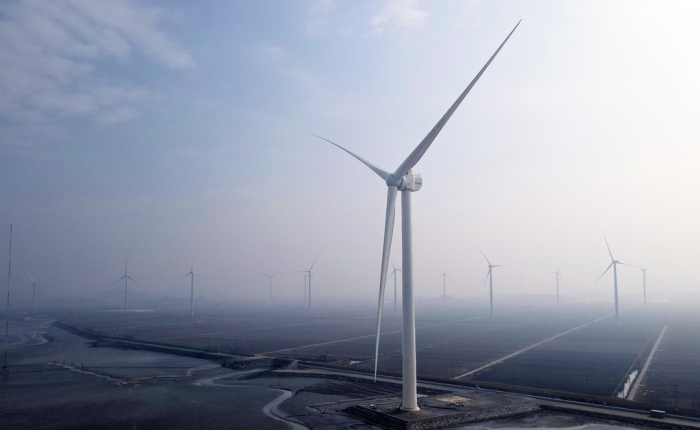Energy
Korea shipbuilders throttle up wind farm business
Samsung develops 15 MW offshore wind floater and Hyundai speeds up development of the unit; Daewoo focuses on WTIV
By Jul 04, 2022 (Gmt+09:00)
3
Min read
Most Read
LG Chem to sell water filter business to Glenwood PE for $692 million


Kyobo Life poised to buy Japan’s SBI Group-owned savings bank


KT&G eyes overseas M&A after rejecting activist fund's offer


StockX in merger talks with Naver’s online reseller Kream


Mirae Asset to be named Korea Post’s core real estate fund operator



South Korea’s major shipbuilders are competing to lead the global wind farm industry, an emerging game-changer in the renewable energy sector, which generates power through offshore floating facilities.
Offshore wind farm operators can set up turbines regardless of the depth of water or submarine topography. There is also no need to buy land for power generation.
Samsung Heavy Industries Co. led the development of offshore wind floaters among the Big Three shipbuilders including Hyundai Heavy Industries Co. and Daewoo Shipbuilding & Marine Engineering Co.
An offshore wind floater supports a wind turbine so the equipment can stably generate power on the ocean. Those shipbuilders are able to utilize their know-how on floating production storage and offloading (FPSO) vessels for the offshore wind floater.
Samsung has developed a 15 megawatt (MW) offshore wind floater and is about to win a ship classification approval on the unit, according to industry sources on Sunday. Last year, Samsung unveiled a 9.5 MW model. The company is aiming for the government-led wind farm project to generate 6 GW of power in the East Sea with its floaters.
“We designed the 15 MW model with analysis on the strength of wind, currents and depth of water in the East Sea,” said a Samsung official. “The unit will be used as the main model for the government’s 6 MW project.”
HYUNDAI HEAVY
Hyundai, the world’s largest shipbuilder, is accelerating the development of a 15 MW unit after unveiling its own 10 MW floater model last year. Smaller floaters are already in the commercialization stage.
The company has been working on an 8 MW pilot project off Jeju Island with a schedule to install facilities in 2024.
“We are producing floaters to be used in the East Sea where the wind is strong,” said a Hyundai official. “We are focusing on the development of models that can withstand tough typhoons through water tank experiments.”
Doosan Enerbility Co., formerly known as Doosan Heavy Industries & Construction Co., has been testing 8 MW models since last year after being selected as a project manager for an 8 MW floating offshore wind farm system development by the Korea Institute of Energy Technology Evaluation & Planning.

Offshore wind farms are better for South Korea than onshore wind farms or solar power plants as the peninsula is surrounded by sea on three sides, an industry source said.
“Once the 15 MW floaters become common, price competitiveness is expected to significantly improve,” the source said.
CONCERNS EMERGE OVER POTENTIAL POLICY SHIFT
Daewoo is specialized in wind turbine installation vessels (WTIV) that cost about 300 billion-400 billion won ($231 million-$308 million).
Global offshore wind power installation capacity is forecast to grow to 228 GW in 2030 and 1,000 GW in 2050 from 30 GW in 2020, according to the International Renewable Energy Agency (IRENA).
South Korean authorities and companies have been working to take the lead in the offshore wind far industry. But concerns emerged over a potential policy shift as the new government often opposes policies sought by the previous administration, industry sources said. They are worried the new government may cut support to the sector.
“Floating wind power is a renewable energy perfectly suited to Korea,” said another industry source. “We need to steadily nurture a business, which has directionality and potential, without any wobble.”
Write to Jeong Min Nam at peux@hankyung.com
Jongwoo Cheon edited this article.
More to Read
-
 EnergyKorean companies’ race heats up in $2.8 tn global wind farm markets
EnergyKorean companies’ race heats up in $2.8 tn global wind farm marketsAug 05, 2021 (Gmt+09:00)
2 Min read
Comment 0
LOG IN


